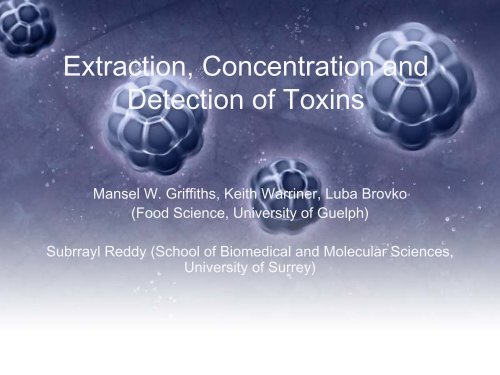Extraction, Concentration and Detection of Toxins
Extraction, Concentration and Detection of Toxins Extraction, Concentration and Detection of Toxins
Extraction, Concentration and Detection of Toxins Mansel W. Griffiths, Keith Warriner, Luba Brovko (Food Science, University of Guelph) Subrrayl Reddy (School of Biomedical and Molecular Sciences, University of Surrey)
- Page 2 and 3: Objectives • Fabricate hydrogel i
- Page 4 and 5: Enterotoxin B • Mw 28 kDa • 240
- Page 6 and 7: Protein Imprinted Polymers Polymeri
- Page 8 and 9: Retention of enterotoxin by polymer
- Page 10 and 11: Impedimetric Immuno-assay based on
- Page 12 and 13: What are conducting polymers? Polyc
- Page 14 and 15: Electrochemical characterization of
- Page 16 and 17: Principle Antibody Antigen BSA Sila
- Page 18 and 19: Detection Strategy Silane Polypyrro
- Page 20 and 21: Future Work • Further optimize my
- Page 22 and 23: Principle of toxicity biosensor [AT
- Page 24 and 25: Other luminescent toxicity biosenso
<strong>Extraction</strong>, <strong>Concentration</strong> <strong>and</strong><br />
<strong>Detection</strong> <strong>of</strong> <strong>Toxins</strong><br />
Mansel W. Griffiths, Keith Warriner, Luba Brovko<br />
(Food Science, University <strong>of</strong> Guelph)<br />
Subrrayl Reddy (School <strong>of</strong> Biomedical <strong>and</strong> Molecular Sciences,<br />
University <strong>of</strong> Surrey)
Objectives<br />
• Fabricate hydrogel imprinted polymers for concentration<br />
<strong>of</strong> Staphylococcus aureus enterotoxin B<br />
• Construct impedimetric immuno-sensors to detect<br />
enterotoxin B<br />
• Develop a pathogenicity biosensor
Staphylococcal Enterotoxin B<br />
• Bacterial toxin<br />
– Staphylococcus aureus<br />
• Easily soluble in water<br />
• Very resistant to temperature fluctuations<br />
– Withst<strong>and</strong>s boiling for several minutes<br />
– Freeze dried remains active for one year
Enterotoxin B<br />
• Mw 28 kDa<br />
• 240 Amino Acids<br />
• LD 50 30ng/Kg<br />
• <strong>Detection</strong> limits 1ng
Development <strong>of</strong> Hydrogel-based Molecularly<br />
Imprinted Polymers (HydroMIPs) for Protein<br />
Recognition<br />
Dr Sub Reddy <strong>and</strong> Quan Phan<br />
School <strong>of</strong> Biomedical <strong>and</strong> Molecular Sciences<br />
University <strong>of</strong> Surrey, UK
Protein Imprinted Polymers<br />
Polymerisation<br />
Electrostatic <strong>and</strong> hydrogen<br />
bonding interactions between<br />
monomer <strong>and</strong> protein<br />
Loose network<br />
Protein imprinted<br />
polymer<br />
Template<br />
elution<br />
Rebinding
Molecularly Imprinted Polymer Hydrogels:<br />
‘Nano-play-dough!’<br />
TEMED<br />
Polyacrylamide
Retention <strong>of</strong> enterotoxin by polymer<br />
10% AcOH SDS washes after 1mg/40µl enterotoxin B reloaded into<br />
enterotoxin B MIP (10% cross linking)
Points to consider<br />
• Effect <strong>of</strong> crosslinking density on SEB imprinting<br />
• Effect <strong>of</strong> pH <strong>of</strong> imprinting<br />
• Effect <strong>of</strong> co-polymerisation using other functional<br />
monomers (hydroxy-acrylamide;<br />
hydroxyethylmethacrylate (HEMA))<br />
• Optimised method <strong>of</strong> eluting SEB<br />
• Method <strong>of</strong> quantifying eluted SEB from HydroMIP<br />
matrix.
Impedimetric Immuno-assay based on<br />
Modified Conducting Polymer Electrodes<br />
Keith Warriner<br />
University <strong>of</strong> Guelph
Conducting Polymer Electrodes<br />
• Free st<strong>and</strong>ing conducting polymer films<br />
• Low cost (
What are conducting polymers?<br />
Polyconjugated polymers with<br />
high electrical conductivities, low<br />
ionization potentials, high<br />
electronic affinities<br />
Applications<br />
Stealth (Radar Absorbing)<br />
LED display<br />
Fuel cell<br />
Organic computers<br />
Sensors
Formation <strong>of</strong> conducting polymer<br />
electrode<br />
Preconditioning:<br />
Pyrrole(0.5M) & SDS(1mM)0<br />
Microporous polycarbonate membrane<br />
(45mm ,10μm pore size)<br />
Polymerization:<br />
FeCl 3<br />
(0.4M) & lactic acid (0.1M)<br />
Polymer electrode
Electrochemical characterization <strong>of</strong><br />
polypyrrole electrodes<br />
Cyclic voltammetry<br />
Impedance<br />
spectroscopy<br />
H<strong>and</strong>held FRA<br />
Solartron Impedance Analyser
Reusable Electrode assembly<br />
Reaction well<br />
Polymer film<br />
Top plate with<br />
reaction well<br />
(inside view)<br />
Copper connections
Principle<br />
Antibody<br />
Antigen<br />
BSA<br />
Silane<br />
Polypyrrole<br />
Paramagnetic bead
Sensor Response to Salmonella<br />
0<br />
-500<br />
Z"<br />
-1000<br />
-1500<br />
-2000<br />
-2500<br />
Background<br />
Sal Extract<br />
-3000<br />
1 10 100 1000 10000 100000<br />
Frequency
<strong>Detection</strong> Strategy<br />
Silane<br />
Polypyrrole<br />
Antigen<br />
BSA blocking agent<br />
Antibody<br />
Paramagnetic bead
Myoglobin <strong>Detection</strong><br />
• Myoglobin model for SEB<br />
• 100ng Myoglobin<br />
• BSA blocking agent<br />
• Anti-myoglobin dynabeads<br />
-1 00 00<br />
-7500<br />
-5000<br />
Z''<br />
Myoglobin<br />
BSA blocking agent<br />
Dynabeads 7 anti -myogl obin<br />
Dynabeads<br />
BSA<br />
Myoglobin<br />
-2500<br />
0<br />
0 2500 5000 7500 10000<br />
Z'
Future Work<br />
• Further optimize myoglobin detection protocol.<br />
• Repeat experiments with SEB<br />
• Integrate hydrogel MIP with detection platform
Cell-based Biosensors<br />
Mansel W. Griffiths, Luba Brovko, Nidham Jamaldeen<br />
University <strong>of</strong> Guelph
Principle <strong>of</strong> toxicity biosensor<br />
[ATP] [Ca 2+ ]
Expression <strong>of</strong> luciferase <strong>and</strong> aequorin genes in<br />
HeLa cells in the presence <strong>of</strong> human complement<br />
component C9<br />
a) luciferase<br />
b) aequorin
Other luminescent toxicity biosensors
The future looks bright



